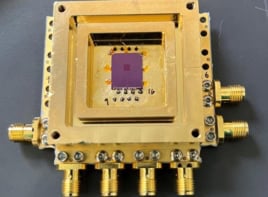
Exotic structures known as “space–time crystals” could soon become reality, thanks to research carried out by a collaboration of physicists in the US and China. The researchers, developing an idea put forward by theoretical physicist Frank Wilczek, of the Massachusetts Institute of Technology in the US, have shown how a crystal made of trapped ions could rotate persistently, even when in its lowest energy state, enabling it to break temporal as well as spatial symmetry.
Normal crystals consist of atoms or molecules arranged in ordered 3D structures, which form below a certain temperature in order to minimize the potential energy within the material. The carbon atoms in diamond, for example, experience an attractive force at longer distances but a repulsive force at smaller scales, meaning that their energy is at a minimum when they are separated from one another by approximately the same intermediate distance. Contrastingly, at higher temperatures, the atoms in a crystal can exist in many more disordered states than ordered states and if the former tends to prevail, it causes the material to melt. “Crystals are a victory of energy over entropy,” says Wilczek.
Timely symmetry breaking
Wilczek came up with the idea of a “time crystal” after asking himself whether a material at low temperatures could be structured in time, rather than space or in addition to it. A normal crystal is said to break spatial symmetry because its constituent particles line up in specific directions, rather than being regularly spaced (as they are at higher temperatures). Breaking temporal symmetry, analogously, simply means that an object or a collection of particles experiences some kind of systematic change in time. As Wilczek points out, this is true of planets in the solar system as well as clocks, for example. But these are systems that were set in motion by some kind of external energy source and will eventually run down. Wilczek wondered whether motion might also be possible in isolated systems that exist in their ground states.
He concedes that this idea is “perilously close” to that of a perpetual motion machine. He points out that, being in their ground states, such systems could not be employed to produce useful work. They would, however, require energy to be stopped. “They would generate a form of perpetual motion”, he says, “which is a little scary to say for someone with a reputation in physics.”
Reservations aside, Wilczek realized that superconductors come close to acting in this way, since they exist in their lowest state but transmit an electrical current. However, they fall short because the current does not change in time. To turn a superconductor into a time crystal, Wilczek proposed varying a supercurrent to give it a temporal peak, which, when travelling around a superconducting ring, would resemble “a mouse moving inside a snake”. He found mathematically that such a scheme is in fact possible, and that the system’s finite kinetic energy is allowed because it results from a larger drop in the system’s potential energy.
Ion trapping
Xiang Zhang and Tongcang Li of the University of California, Berkeley and colleagues, however, think that this particular scheme would be difficult to realize in practice because it would require particles with like-charge to attract one another in order to create the lump in the current. Their proposal instead involves trapping ions at very low temperatures and exploiting their mutual repulsion so that they arrange themselves into a ring shape. This ring, explains Li, would be similar to a conventional crystal. By then setting up a magnetic field with certain values across the ring, the ring could be made to rotate continuously in its lowest energy state – in other words, he says, it would become a space–time crystal.
Li says that the main challenge in actually building such a device will be cooling ions in small enough traps down to sufficiently low temperatures. He and his colleagues calculate that to form a space–time crystal one tenth of a millimetre across, 100 beryllium ions would need to be cooled down to just one billionth of a kelvin, with larger rings requiring even lower temperatures. But he is confident that this technical demand can be met, either by his own group or other groups. “It can be overcome in the near future with the development of ion trap technologies”, he says, adding that exactly when this happens “depends on funding and many other factors”.
Zhang believes, that, once built, such a device could “provide a new dimension for exploring many-body physics and emerging properties of matter” and may also improve our understanding of symmetry breaking, such as that which is believed to have given particles their mass as the universe expanded and cooled.
Wilczek, who describes the trapped-ion proposal as “much more spelled out and professional” than his own scheme, also argues that space–time crystals could have practical applications, even if it is not clear at this stage what those applications are. “This work is exploring new states of matter”, he says, “and could lead in unexpected directions.”
The paper is available on the arXiv pre-print server (arXiv:1206.4772v1).



